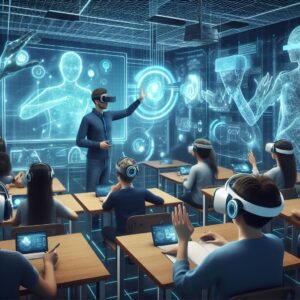Introduction:
The integration of technology into the classroom has revolutionized the educational landscape, offering unprecedented opportunities for teachers and students alike. In a world where digital literacy is as fundamental as reading and writing, the role of technology in education is not just beneficial but essential. This article explores the myriad ways technology is enhancing classroom experiences, facilitating personalized learning, and preparing students for a future dominated by digital proficiency.
Technology for the classroom is no longer a luxury but a necessity. It provides educators with a powerful arsenal of tools to engage students, cater to diverse learning styles, and manage educational resources more effectively. From primary schools to universities, technology is paving the way for innovative teaching methods, making education more interactive, and accessible.
Key Technologies Transforming the Classroom:

• Interactive Whiteboards: These dynamic displays are a step up from traditional chalkboards, allowing teachers to present multimedia content, write and draw in digital ink, and interact with students in real-time.
• Learning Management Systems (LMS): Platforms like Moodle, Blackboard, and Canvas enable the creation, distribution, and tracking of educational content online, providing a centralized hub for students and teachers to collaborate.
• Educational Apps and Games: With an array of apps designed for educational purposes, learning is becoming more engaging for students, allowing for gamification of lessons and enhancing retention rates.
• Virtual and Augmented Reality: VR and AR bring an immersive learning experience to the classroom, making complex concepts more tangible and captivating for students of all ages.
• Cloud Computing: The cloud has revolutionized the way educational resources are stored and shared, ensuring that students and teachers have access to materials anytime, anywhere.
The Benefits of Classroom Technology:
The adoption of technology in education has numerous benefits:

Personalized Learning: Technology allows for customized educational experiences, catering to the individual needs and pace of each student.
Improved Engagement: Interactive tools and digital content make learning more engaging, increasing student motivation and participation.
Access to Resources: The Internet provides a vast repository of information, making research and information retrieval a breeze for students.
Collaboration and Communication: Digital platforms facilitate better collaboration among students and between students and teachers, both inside and outside the classroom.
Preparation for the Future: By integrating technology in education, we are preparing students for a digital world, equipping them with the necessary skills for the workforce.
Challenges and Considerations:
Despite the benefits, the implementation of technology in the classroom is not without its challenges. Issues of equitable access, teacher training, and the potential for distraction must be addressed. Schools must ensure that all students have access to the technology needed to participate fully in their education. Moreover, teachers must be provided with the necessary training to integrate technology into their teaching effectively.
Advanced Technologies Shaping Modern Education:
Artificial Intelligence (AI) in Education: AI is playing a crucial role in personalizing learning. Through adaptive learning technologies, AI systems can analyze a student’s performance and tailor the curriculum to challenge them just enough to encourage growth without causing frustration. Additionally, AI can automate administrative tasks, allowing teachers to focus more on teaching and less on paperwork.
Robotics and Coding: Robotics kits and coding lessons are becoming more commonplace in classrooms, offering students hands-on experiences with engineering and programming. These skills foster problem-solving abilities and logical thinking, which are invaluable in today’s tech-driven world.
Tech-Enhanced Assessments: Digital assessments provide immediate feedback to students, enabling them to understand their learning gaps quickly. For teachers, analytics from these assessments can inform instruction, allowing for data-driven decision-making.
Flipped Classrooms and Blended Learning: With technology, the flipped classroom model has gained traction, where students learn new content online by watching video lectures at home and apply what they learn in the classroom. Blended learning combines online educational materials and opportunities for interaction online with traditional place-based classroom methods.
The Role of Technology in Supporting Diverse Learners:
Technology also has the power to break down barriers for students with disabilities or those who require additional support. Here’s how:
Assistive Technology: Tools such as screen readers, text-to-speech, and voice recognition software make learning more accessible for students with disabilities.
Language Learning Software: These programs assist English Language Learners (ELL) and students learning foreign languages through interactive and immersive experiences.
Strategies for Effective Technology Integration:
For technology to be effective in the classroom, it must be integrated thoughtfully. Some strategies include:
Professional Development: Ongoing training for teachers is critical for effective technology integration. Professional development can include workshops, webinars, and collaborative planning sessions.
Balanced Approach: While technology can be an amazing tool, it’s crucial to balance its use with traditional teaching methods to ensure that the foundation of good pedagogy remains at the center of education.
Digital Citizenship: Teaching students about responsible online behavior and digital footprint is important to ensure that they know how to navigate the online world safely.
Evolving Education Policies:
To support the infusion of technology in the classroom, education policies at the local, state, and federal levels are evolving. Investment in infrastructure, like high-speed internet and up-to-date hardware, is essential. Policies are also addressing issues of digital equity to ensure that all students have equal access to technology.
Conclusion:
As the digital age continues to evolve, the use of technology in the classroom is becoming increasingly important. By integrating the latest technological tools and resources, educators can enhance the learning experience and better prepare students for the future. While there are challenges to overcome, the potential benefits make the pursuit of technology-integrated education a worthy endeavor.

Leave a Reply